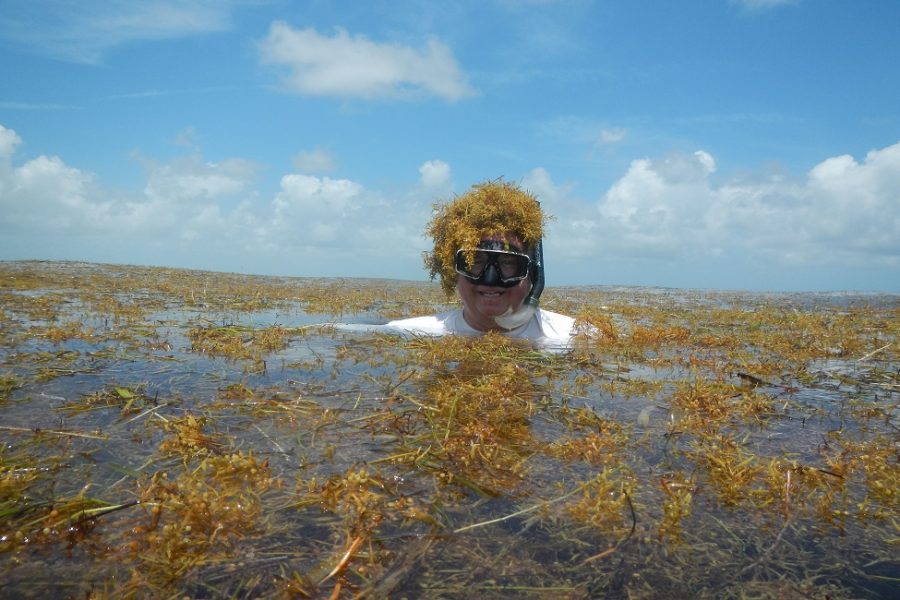FAU professor researches Florida’s algae crisis
FAU professor and researcher Brian Lapointe is trying to spread awareness about the harmful effects of algae blooms in Florida.
Brian Lapointe, an FAU researcher and professor, swimming in Sargassum. Sargrassum has harmful affects on Florida’s marine life — and Lapointe is trying to spread awareness. Photo courtesy of FAU
March 4, 2020
The seaweed that litters the Florida coast for miles with yellow-brown mounds, a fishy odor and an entanglement of marine trash, called Sargassum, shouldn’t be there — and FAU researchers are working to find ways to keep track of the amount of Sargassum off the coast and finding out possible solutions to this crisis.
Harbor Branch professor Brian Lapointe and other researchers have determined that nitrogen, as well as other excess nutrients in the water, have contributed to the increase of Sargassum on Florida beaches and off the coast. According to an article co-authored by him in 2019, there is a 5,500-mile algae belt, known now as the world’s largest algae bloom, that is growing from the coast of West Africa to the Caribbean Sea and the Gulf of Mexico — which means the problem is growing, Lapointe argues.
“People need to be concerned about [Sargassum] not just because of the economic, environmental, and health impacts,” Lapointe said, “but also because it illustrates the growing human footprint in the nutrient cycles of our planet. In this case it’s the nitrogen cycle.”
What is Sargassum and what’s the problem?
Sargassum is a macroalgae, meaning it’s a type of algae that is made up of many cells instead of just one. Therefore, it is large enough for the average person to see without a microscope. It is most prevalent during spring and summer months because that is when it grows the best.
Because of its look and smell, the Sargassum drives tourists away from Florida beaches and creates economic problems. According to Naples Daily News, in 2018, Lee County and Collier County projected to lose nearly $4.5 billion due to water quality issues caused by algae blooms, such as this one.
Sargassum contains heavy poisonous metals like arsenic and hydrogen sulfides, and when it rots, these toxins are released into the air within 48 hours of being washed on to the beach, according to Lapointe.
So, why is Florida being most affected by the Sargassum? The answer to this question lies in the currents that are off Florida’s coast. The Sargasso Sea is formed by a circle of currents in the Atlantic Ocean. First, the Gulf Stream brings nutrient-dense Amazon River discharge off the coast of Florida and out to sea, where it is then pushed towards the West African coast by the Canary Current, back out into the Atlantic Ocean by the North Equatorial Current, and back to the coast of Florida by the Antilles Current. Then the Gulf Stream picks it up again and the process begins again.
This is why the lesser-known name of the part of the Atlantic Ocean off the coast of Florida is the “Sargasso Sea.” Because the amount of Sargassum has increased over the recent years, the amount of it that washes up on Florida’s beaches has also grown.
“We have a community of factors, such as increased fires and increased fertilizer use in Brazil, since 2011,” Lapointe said about the increasing amount of Sargassum. “But, most of all: the event related to climate change, which is the flooding in the Amazon watershed, the largest watershed in the world, which brings excess nutrients in the rivers, then out to sea.”
The excess nutrients collected through Sargassum’s trip through the tropics remain at the top of the sea surface along with the Sargassum because the freshwater they are dissolved in is less dense than the saltwater. So, it continues to enrich the Sargassum, causing excess growth. As the amount of these nutrients in the water increases along with more pollution, the larger these algae blooms will grow. These enormous algae blankets then block out sunlight from penetrating the sea surface, thus causing marine life, such as coral, to die from inability to conduct photosynthesis, which is how a lot of primary sources of food and energy in the ocean live.
Therefore, Sargassum is not only ugly, it is deadly to marine life.
“We are going to increasingly lose our coastal ecosystems — well, what’s left of them,” Lapointe said.
As long as the nutrient cycles are going to be affected by excess nutrients, Lapointe predicts the Sargassum problem will only get larger.
According to the Florida Department of Health, the hydrogen sulfide caused by Sargassum can irritate your eyes, nose and throat.
“This could get so bad that we may need to evacuate our coastal areas where there is a lot of Sargassum,” said Lapointe.
If you want to hear more about how Sargassum is affecting Florida’s coast, Lapointe will be speaking on a panel during Ocean Day at the Hallandale Beach Cultural Community Center on March 28.
Annalise Wellman is a contributing writer for the University Press. For information regarding this or other stories, email [email protected].
















